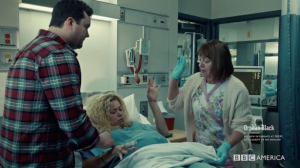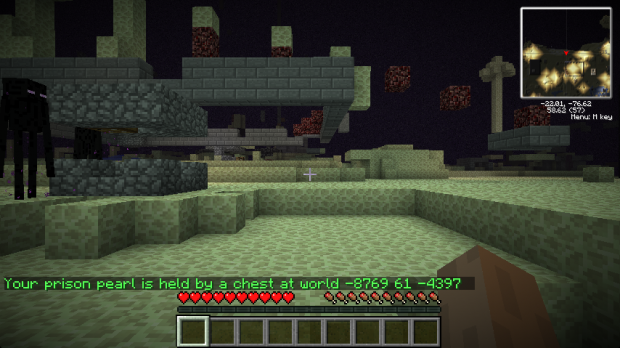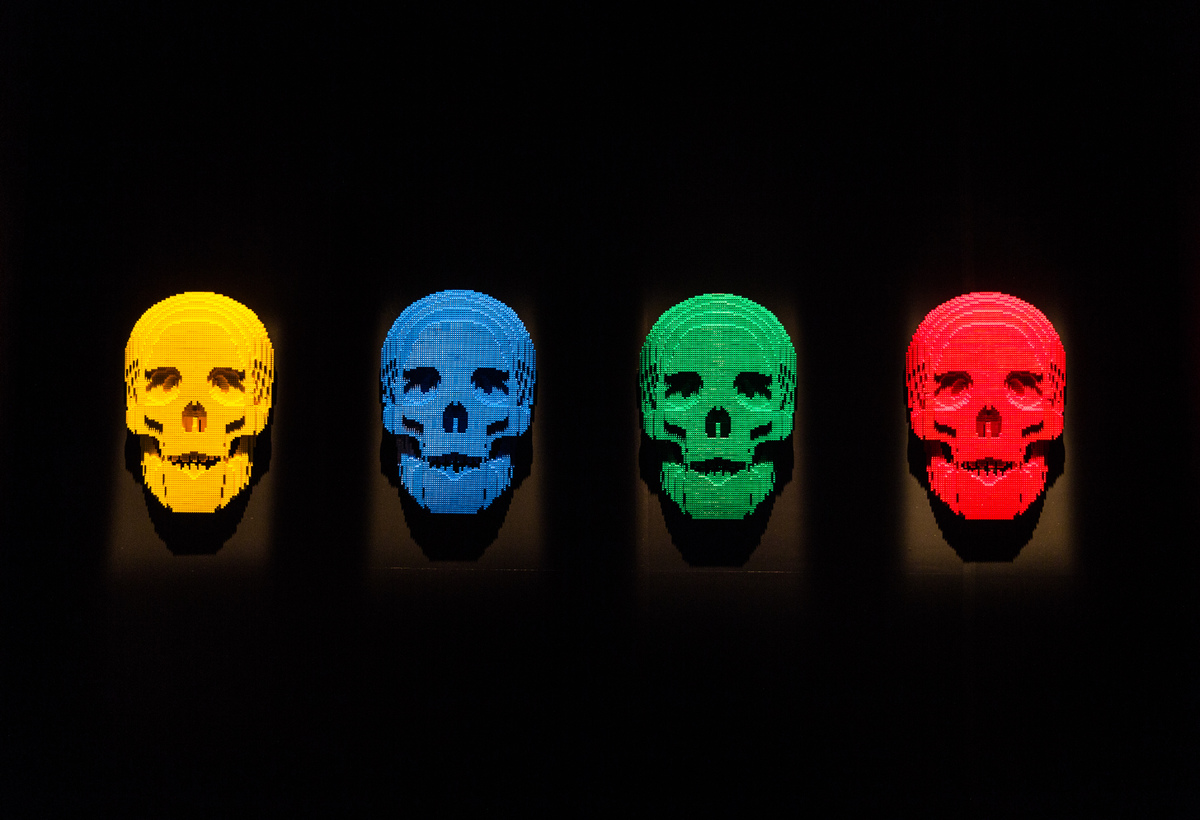The fifth and final season of Orphan Black began a couple weeks ago. It’s a show about human clones—about how being a clone might impact both one’s personal identity and one’s relationship to others (that is, one’s potential roles as sister, daughter, mother, partner). But more than that, the show examines the implications the science and technology behind human cloning might have for the ways we think about the body, and especially for the ways women’s bodies are often sought to be controlled, disciplined, and constrained.
This seems especially true for the ways Orphan Black explores pregnancy, reproduction, and motherhood. Indeed, one of the main plotlines of the show deals with the fact that most of the clones (played by Tatiana Maslany, who is a god of an actor) are women who have been intentionally engineered to be sterile. But two of the clones—Sarah and Helena, who also happen to be twins—are not infertile, for Sarah has a daughter Kira and Helena is currently pregnant with twins.
 Helena’s pregnancy has been of particular interest to me this season; in the first two episodes thus far, Helena has to go to the hospital after a stick punctures her stomach. She makes a quick recovery (as do her twins), but the hospital wants to keep her there to do additional tests. And the whole time, the doctors and nurses evade her questions and are slow to explain what concerns they have about her and her babies. Helena, not trusting the doctors, proceeds to escape the hospital.
Helena’s pregnancy has been of particular interest to me this season; in the first two episodes thus far, Helena has to go to the hospital after a stick punctures her stomach. She makes a quick recovery (as do her twins), but the hospital wants to keep her there to do additional tests. And the whole time, the doctors and nurses evade her questions and are slow to explain what concerns they have about her and her babies. Helena, not trusting the doctors, proceeds to escape the hospital.
While watching these events unfold, I was reminded of Marika Seigel’s book The Rhetoric of Pregnancy, in which Seigel argues that the “medical-technological system of prenatal care” is one in which pregnant bodies are deemed risky bodies, bodies that then require “a program of self-discipline—under the supervision of a qualified medical professional—that would keep those risks in check.” And Seigel argues that this system constructs these risky bodies as ones that require management and discipline not for the health and safety of the mother but rather “in order to perfect the fetus.” As such, Seigel contends that the system of prenatal care is structured around three assumptions—that “pregnant bodies can become the sites through which social, political, and environmental risks are managed,” that “the role of doctors, employers, law enforcement officials, fathers, and other ‘enforcers’ of prenatal care practices is to impose…discipline,” and that the goal “of the work of pregnancy…is assumed to be not only a healthy fetus…but also a normal fetus.” And because of these assumptions, pregnant women, then, do not have a voice in this system of prenatal care, and, instead, “their role is to insert themselves passively/piously into that system so that they can be observed and monitored for the good of the nation.”
Helena, it would seem, through her distrust of the doctors and nurses, and through her escape from the hospital, actively rejects this system of prenatal care, rejects its attempts to control and discipline her pregnant body, and rejects its efforts to evade her questions and to, thus, render her passive and voiceless. Indeed, in her escape, Helena stabs her doctor through the cheek (that is, through the mouth) with a needle—a move that seems to represent her desire to subvert this prenatal system by rendering it voiceless instead.
To be sure, Helena’s actions in these scenes seem especially timely in light of NPR and ProPublica’s recent joint investigation into maternal mortality, in which they find that “every year in the U.S., 700 to 900 women die from pregnancy or childbirth-related causes, and some 65,000 nearly die—by many measures, the worst record in the developed world.” And some of these “many measures” that they expand on are alarming:
American women are more than three times as likely as Canadian women to die in the maternal period (defined by the Centers for Disease Control as the start of pregnancy to one year after delivery or termination), six times as likely to die as Scandinavians. In every other wealthy country, and many less affluent ones, maternal mortality rates have been falling…But in the U.S., maternal deaths increased from 2000 to 2014. In a recent analysis by the CDC Foundation, nearly 60 percent of such deaths are preventable.
Some of the reasons for this rise in maternal deaths, their investigation finds, include the fact that “[n]ew mothers are older than they used to be, with more complex medical histories. Half of pregnancies in the U.S. are unplanned, so many women don’t address chronic health issues beforehand. Greater prevalence of C-sections leads to more life-threatening complications. The fragmented health system makes it harder for new mothers, especially those without good insurance, to get the care they need. Confusion about how to recognize worrisome symptoms and treat obstetric emergencies makes caregivers more prone to error.” But what is also significant—and what brings to mind, too, Seigel’s arguments that the system of prenatal care is one that seeks to manage the “risky” bodies of pregnant women in order to produce healthy, “normal” fetuses—is the ways these maternal death statistics contrast with those of infant mortality:
Yet the worsening U.S. maternal mortality numbers contrast sharply with the impressive progress in saving babies’ lives. Infant mortality has fallen to its lowest point in history, the CDC reports, reflecting 50 years of efforts by the public health community to prevent birth defects, reduce preterm birth, and improve outcomes for very premature infants. The number of babies who die annually in the U.S.—about 23,000 in 2014—still greatly exceeds the number of expectant and new mothers who die, but the ratio is narrowing.
Thus, NPR and ProPublica’s investigation concludes, “In recent decades, under the assumption that it had conquered maternal mortality, the American medical system has focused more on fetal and infant safety and survival than on the mother’s health and wellbeing.”
It seems that it’s no wonder, then, that in this social context, this context in which pregnant bodies are deemed risky, in which maternal deaths are on the rise, in which pregnant women are told they must passively submit to the system of prenatal care, representations of motherhood are often similarly problematic. Kate Gray argues that this seems to be the case in many video games (although, of course, such problematic representations are not unique to games but occur across mediums and forms), and she argues that games “are not too great at portraying motherhood” and that “the motherhood stories just don’t get told.” Indeed, she continues, “If everything I learned about motherhood was from games, a large part of it would be ‘you die roughly five minutes after giving birth, surviving just long enough to leave a memento or a letter that will later serve as the motivation for your child to do some big quest,’” a lesson in maternal death that would seem to be in keeping with NPR and ProPublica’s findings. As such, Gray ultimately argues that mothers in video games are represented less as “nurturing, sentient human being[s]” and more as “plot device[s].”
 In thinking about this, though, I wonder how a game like Bound (which Alisha and I have written about before) might complicate the ways games typically represent motherhood, for the game, instead of making use of mothers as passive plot devices, allows players to actively inhabit the role of a pregnant woman, as we play through her journey to process her traumatic memories of her own childhood. It seems to me though, that the game might be, to harken back to Seigel’s assertions, continuing to construct the pregnant body as a risky one, although this riskiness seems to function slightly differently. That is, rather than solely representing the pregnant body as one that might risk the physical health of a child, Bound seems to construct the pregnant body as one that might also house the risk of causing emotional and psychological trauma in one’s children. Because the pregnant woman in Bound explores memories of her own trauma at the hands of her parents, she seems to be doing so because she does not want her own motherhood to repeat such trauma for her children—and, thus, she sees her own pregnant body as one of risk.
In thinking about this, though, I wonder how a game like Bound (which Alisha and I have written about before) might complicate the ways games typically represent motherhood, for the game, instead of making use of mothers as passive plot devices, allows players to actively inhabit the role of a pregnant woman, as we play through her journey to process her traumatic memories of her own childhood. It seems to me though, that the game might be, to harken back to Seigel’s assertions, continuing to construct the pregnant body as a risky one, although this riskiness seems to function slightly differently. That is, rather than solely representing the pregnant body as one that might risk the physical health of a child, Bound seems to construct the pregnant body as one that might also house the risk of causing emotional and psychological trauma in one’s children. Because the pregnant woman in Bound explores memories of her own trauma at the hands of her parents, she seems to be doing so because she does not want her own motherhood to repeat such trauma for her children—and, thus, she sees her own pregnant body as one of risk.
I don’t really know what to make of all this, and I don’t really know how to unpack the risky pregnant bodies we see in Bound and Orphan Black (especially since the latter’s final season still has a way to go before any conclusions are revealed). That said, in light of all this, Helena’s rejection of the system of prenatal care seems telling. And Bound’s pregnant protagonist’s efforts to confront her own risky body also seem telling. While these two women might perhaps view their bodies, their pregnancies, their motherhoods differently, it would seem that both, at least, seek agency in their own maternal processes—that they reject the ways their different contexts or locations (be they medical or familial) seek to discipline or control them. That they, instead, seek to assert their own agency in their roles as mothers.




